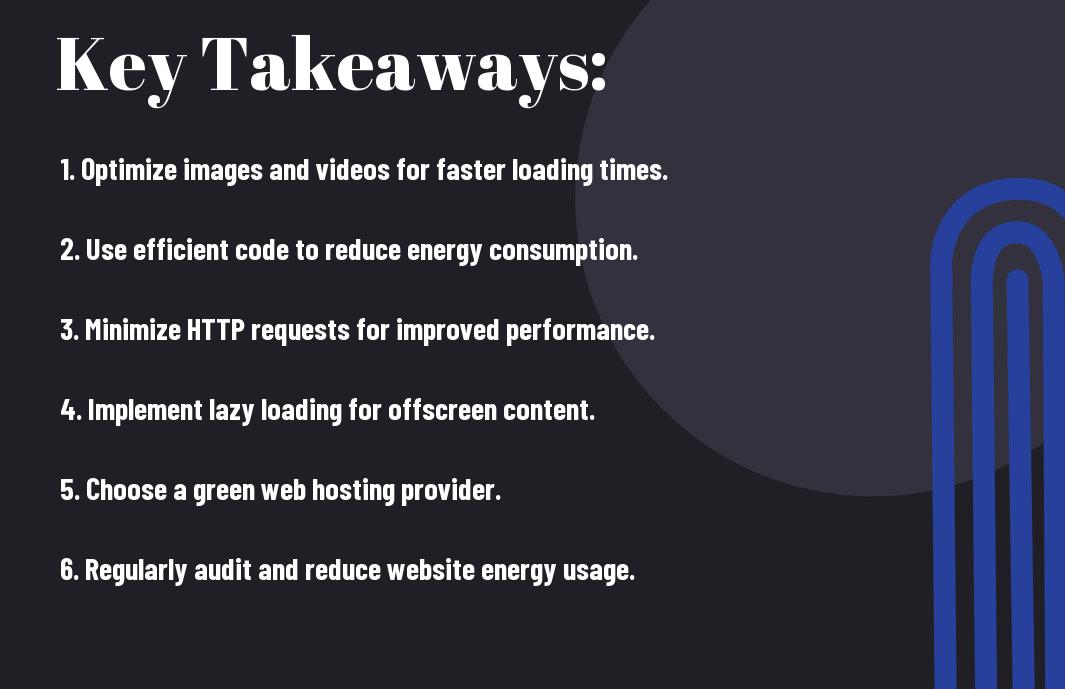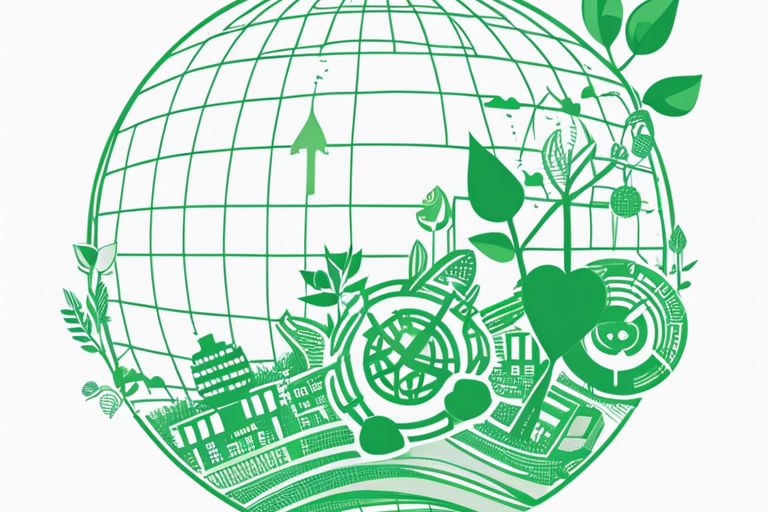With the digital world expanding, sustainable web development is crucial for reducing its environmental impact. By implementing eco-friendly best practices in your web projects, you can significantly lower carbon emissions and contribute to a greener future. In this guide, we will explore strategies and tips to help you make your web development process more environmentally friendly, without sacrificing performance or innovation. Let’s pave the way for a more sustainable digital landscape together.
Key Takeaways:
- Optimize Images: Compress images and use the correct format to reduce file size and improve website loading speed.
- Minimize HTTP Requests: Reduce the number of elements on a page to lower the number of HTTP requests, which can enhance website performance and reduce energy consumption.
- Use Sustainable Hosting: Choose eco-friendly web hosting providers that use renewable energy sources to power their servers, reducing the carbon footprint of your website.
The Environmental Impact of Web Development
Carbon Footprint of Data Centers
One of the significant environmental impacts of web development is the carbon footprint of data centers. These data centers house servers that store, manage, and process the vast amount of data required for websites and web applications. The energy consumption of data centers contributes to carbon emissions, which are harmful to the environment.
Energy Consumption of Devices
With the proliferation of smartphones, tablets, laptops, and other internet-connected devices, the energy consumption of devices used to access websites also plays a role in the environmental impact of web development. Charging these devices and keeping them powered up requires electricity, which comes from various sources, including fossil fuels.
It is crucial to be mindful of the energy consumption not only of the data centers hosting websites but also of the devices you use to access the internet. Reducing energy consumption can help lower carbon emissions and lessen the environmental impact of your online activities.

Eco-Friendly Web Design Principles
Any Sustainable Web Design in 2023: How Eco-Friendly Practices… can start with incorporating eco-friendly principles into your web design. In the context of eco-friendly web design, paying attention to factors like energy efficiency and resource optimization is crucial. Embracing sustainable practices in your web design not only reduces your carbon footprint but also contributes to a more environmentally conscious digital landscape.
Minimalism and Simple Design
One way to ensure your web design is eco-friendly is by adopting a minimalist and simple design approach. **Using clean and simple layouts**, **minimalist fonts**, and **reducing unnecessary graphics** can significantly decrease the energy consumption of your website. **Optimizing your code** and **minimizing server requests** are also important steps in promoting sustainability through your web design.
Sustainable Color Schemes
EcoFriendly **color schemes** play a significant role in sustainable web design. **Choosing colors that are easy on the eyes** not only enhances user experience but also **reduces screen brightness**, helping to save energy. **Opting for a darker color palette** can also contribute to **lower energy consumption** on devices with OLED or AMOLED screens.
The **right color choices** can create a visually appealing website while **ensuring energy efficiency** and **reducing the environmental impact** of your digital presence.
Accessible Design for Reduced Energy Consumption
Designing **accessible websites** not only benefits users with disabilities but also **contributes to reduced energy consumption**. **Well-structured layouts**, **proper headings**, and **descriptive image alt texts** not only make your website more inclusive but also **help optimize performance**. **Reducing the dependency on plugins** and **implementing responsive design** are also important in creating an eco-friendly web design.
Designing your website with **accessibility in mind** not only **enhances user experience** but also aligns with **sustainable web development practices** to promote a greener digital ecosystem.
Color choices, **layout**, and **design elements** all play a crucial role in making your website eco-friendly. Embracing sustainable web design principles benefits not only the environment but also contributes to a more **user-friendly** and **efficient online experience** for your audience.
Green Coding Practices
Now let’s examine into some green coding practices that can help make your web development more sustainable and eco-friendly.
Efficient Code Writing Techniques
Writing efficient code is important for creating a sustainable website. By writing clean, concise, and well-organized code, you can reduce the amount of server resources needed to load your website. Avoiding unnecessary code, using efficient algorithms, and optimizing your code structure will not only make your website faster but also more eco-friendly.
Optimizing Images and Media
Media files such as images and videos can significantly impact your website’s loading time and server resources. By optimizing your images through compression, resizing, and using modern image formats like WebP, you can reduce your website’s carbon footprint. Remember to lazy load media content to only load them when your visitors need them, further improving your website’s performance and sustainability.
Green coding includes not only optimizing the code but also being mindful of the media you use on your website. Make it a habit to resize and compress images before uploading them, and consider utilizing content delivery networks (CDNs) to deliver media content efficiently.
Leveraging Browser Caching
On top of optimizing your code and media, leveraging browser caching is another crucial step in creating a sustainable website. By instructing browsers to cache resources like images, CSS files, and scripts, you can reduce server requests and improve loading times for returning visitors. This not only enhances your website’s performance but also decreases the environmental impact of repeated resource requests.
This practice allows your website to load faster for users who have visited before, saving both time and energy in the process. By setting appropriate cache headers and durations, you can strike a balance between fresh content and efficient resource utilization.

Sustainable Server and Hosting Options
Green Web Hosting Providers
Keep your environmental impact in check by choosing green web hosting providers for your website. These providers run on renewable energy sources like wind, solar, or hydroelectric power. By hosting your site with a green provider, you can reduce your carbon footprint and support sustainable practices in the tech industry.
Energy-Efficient Server Solutions
With energy-efficient server solutions, you can ensure that your website is running on servers that are optimized for minimal energy consumption. Hosting companies are increasingly investing in energy-efficient servers that reduce power usage without compromising performance. By selecting a hosting provider that prioritizes energy efficiency, you can contribute to a more sustainable digital landscape.
Hosting your website on energy-efficient servers not only helps the environment but also leads to cost savings for hosting companies. These servers typically operate more efficiently, resulting in lower energy bills and reduced operational costs.
Cloud Computing and Virtualization
To sustainably run your website, consider utilizing cloud computing and virtualization technologies. Cloud services offer scalability and resource efficiency, allowing you to meet your website’s demands without over-provisioning server resources. By consolidating your website onto virtual servers through cloud technology, you can optimize resource utilization and reduce energy consumption.
Energy-efficient data centers that power cloud computing services are designed to maximize efficiency and minimize environmental impact. By migrating your website to the cloud, you can take advantage of these sustainable infrastructure solutions while improving the performance and reliability of your online platform.
Reducing Waste in Web Development
Not all web development practices are environmentally friendly. If you want to minimize the digital waste generated by your website, you should follow the 7 Best Practices To Create Sustainable Websites. These best practices will guide you in developing websites that are not only efficient but also sustainable.
Minimizing Digital Waste
One way to reduce digital waste in web development is by optimizing your code and media files. By minimizing unnecessary code and compressing images and videos, you can significantly reduce the carbon footprint of your website.
Repurposing and Recycling Code
To make your web development process more sustainable, consider repurposing and recycling code whenever possible. By reusing code snippets and components from previous projects, you can save time and resources while reducing the amount of new code that needs to be written.
Digital waste is a significant environmental concern, and by repurposing and recycling code, you can contribute to a more sustainable digital ecosystem.
Sustainable Project Management
Digital project management plays a crucial role in reducing waste in web development. By following sustainable project management practices such as setting clear goals, establishing efficient workflows, and regularly assessing the environmental impact of your projects, you can ensure that your web development processes are as eco-friendly as possible.
Another important aspect of sustainable project management is collaborating with your team members and clients to prioritize sustainability and make environmentally conscious decisions throughout the web development process.
I hope this advice is beneficial and encourages you to implement eco-friendly practices in your web development projects.
Measuring and Monitoring Sustainability
Carbon Calculators and Tools
For sustainable web development, it is crucial to calculate and monitor the carbon footprint of your website. **Carbon calculators and tools** are efficient resources that can help you measure the environmental impact of your digital presence. By inputting data such as server energy consumption, user traffic, and website components, these tools can provide you with valuable insights into the emissions generated by your site.
Tracking Energy Consumption and Emissions
To ensure your website’s sustainability, **tracking energy consumption** and emissions is imperative. By using monitoring tools and services, you can keep a close eye on your website’s energy usage and carbon emissions. These insights can help you identify areas where optimizations can be made to reduce environmental impact and improve overall sustainability.
**Measuring and analyzing your website’s energy consumption** and emissions is important for understanding the environmental impact of your online activities. By tracking these metrics, you can make informed decisions on how to optimize your website for sustainability and reduce its carbon footprint.
Setting Sustainability Goals and Benchmarks
The **setting of sustainability goals and benchmarks** is a key step in ensuring that your web development practices align with eco-friendly principles. By establishing clear objectives and targets for reducing energy consumption and carbon emissions, you can track your progress towards a more sustainable digital footprint.
**Setting specific and measurable sustainability goals** allows you to hold yourself accountable and monitor your efforts towards creating a more eco-friendly website. By setting benchmarks, you can continuously strive to improve your environmental performance and make a positive impact on the planet.
Conclusion
Taking this into account, by implementing eco-friendly best practices in your web development projects, you can contribute to reducing the environmental impact of digital technologies. By optimizing your website’s performance, using sustainable hosting solutions, and minimizing energy consumption, you can help create a more environmentally-friendly internet ecosystem.
It is imperative for web developers to prioritize sustainability in their work and make conscious choices to minimize their carbon footprint. By following the eco-friendly best practices outlined in this article, you can play a significant role in promoting a more sustainable approach to web development and help build a greener future for the digital world.